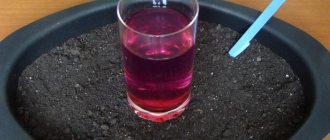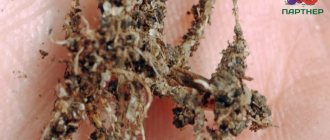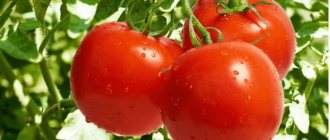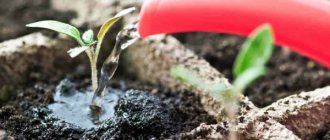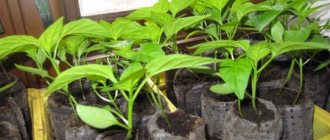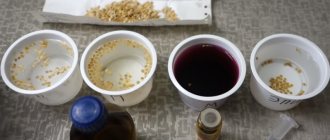The tomato is heat-loving; creating comfortable conditions when growing seedlings is easy, but after planting in open ground, difficulties arise. Tomato planting is carried out from mid-May to the end of June, when during the day the weather is more or less stable and warm, but at night sharp cold snaps can be observed. What temperature can a crop withstand in open ground, what consequences does a violation of the temperature regime entail, how to solve problems that arise during periods of sudden cold snap at night? Let's discuss.
The importance of temperature conditions when growing tomato seedlings
Many inexperienced gardeners, hoping for an early harvest, rush to sow tomato seeds. The result of haste is weakened seedlings and complications in care.
Features of the influence of temperatures on tomato seedlings:
- To avoid problems associated with temperature conditions, seeds should be sown no earlier than mid-March.
- If seedlings are exposed to critically low temperatures, not only the above-ground part suffers, but its root system also dies. After this, plant restoration becomes impossible.
- At each stage of development, seedlings require a certain temperature regime.
Air temperature requirements
In order for seedlings to grow viable, certain temperature conditions are created for them corresponding to the stage of development.
When planting seeds
The seeds are germinated before sowing. This procedure increases their germination rate. Planting material is germinated at temperatures from +25 to +30 °C. At lower values, seeds will germinate much more slowly.
To ensure optimal temperature conditions, germinated seeds are placed on a radiator. It is important to promptly moisten the fabric in which the planting material is wrapped.
When the seeds are sown in the ground, the temperature in the room is maintained from +24 to +26 °C.
How to ensure the required conditions:
- Cover the box with the seeds with film.
- Place foam under the bottom of the box.
- Windows should provide maximum light, so boxes with crops should be placed on the south side.
After germination
When seedlings appear in the seedling boxes, the temperature is adjusted in such a way as to grow the strongest seedlings.
Temperature conditions after germination:
- First week. Maintaining low temperatures during the first week after germination helps prevent sprouts from stretching. Recommended temperatures:
- daytime – from +13 to +18 °C;
- night – from +11 to +14 °C.
- Second week. The temperature is gradually increased. Recommended values:
- on clear days – from +20 to +23 °C;
- in cloudy weather – from +18 to +20 °C;
- night – from +17 to +19 °C.
Many experienced gardeners adhere to other rules; they believe that temperatures should be lower:
- in cloudy weather – from +16 to +19 °C;
- at night – from +10 to +13°C.
Extreme caution must be taken as the temperature drops. Even a loss of 2-3 degrees Celsius can negatively affect seedlings.
A slight drop in temperature can provoke:
- weakening of the root system;
- developmental delay, which will negatively affect productivity.
Overheating has an equally detrimental effect on the development of seedlings. The sprouts stretch out, their stems become thin and weak.
At this stage, daylight hours should be at least 10 hours. If there is not enough light, turn on the lamps. The soil is moistened with a spray bottle, avoiding stagnation of water.
After the pick
If the seeds were sown in a common container, the seedlings have to be picked - planted in separate 0.5 liter glasses.
Recommended temperatures after picking:
- on clear days – from +20 to +23 °C;
- in cloudy weather – from +16 to +18 °C;
- night – from +12 to +15 °C.
At what degrees should young tomatoes be planted?
We must not forget about the correct temperature regime when sowing seeds, which is carried out at +22C - +25C.
After sowing
After the seeds are immersed in the soil, the boxes should be placed in a place where the temperature is maintained at +23C - +25C until germination (after 5 - 6 days).- It is to ensure these temperature indicators that the boxes are covered with glass or covered with plastic film to create a “greenhouse effect”, which is not opened until the shoots appear.
- For future plants, in addition to temperature, light is important, so it is advisable to place the containers on the windowsill of a south-facing window or under artificial lighting lamps.
For growing seedlings
What temperature regime should be used when growing tomato seedlings? When the shoots have already appeared, the temperature should be lowered for a week to +16C - +18C during the day and +11C - +15C at night : such a measure will prevent excessive stretching of the sprouts. Uniform, healthy growth of seedlings will be ensured by thermometer readings frozen at +20C - +22C in bright sun and +18C - +19C in cloudy weather (night readings - +17C - 18C) until the second true leaf appears (in 30 - 35 days after germination).
If the temperature deviates from the recommended parameters, then deviations in the development of plants are also possible: seedlings will stretch upward when the thermometer readings are inflated, and will stop in their development at lower temperatures. But, at the same time, at +14C – +16C, the root system actively begins to develop. A complete stop in the development of a tomato seedling occurs at +10C, and death occurs at +5C.
During and after a dive
The appearance of two true leaves on each seedling is a signal that it is necessary to pick the plants into separate containers. Since this procedure is stressful for fragile plants, the seedlings must be prepared in advance.
3 - 5 days before the expected date of transplanting, the temperature should be lowered to + 16C - + 18C , which will stimulate the development of their protective mechanisms and contribute to future abundant flowering and ovary. The moment of the dive and the period after this procedure should be accompanied by indicators of +20C - +22C on a sunny day, +16C - +18C in cloudy weather and +12C - +14C at night.
The influence of different temperatures on seedlings
Tomato seedlings are very sensitive to the slightest temperature fluctuations. Low and high temperatures are equally harmful to tomato seedlings.
Violation of the temperature regime leads to:
- to a decrease in yield;
- deterioration of immunity.
Low temperatures make the plant stem thick and short, high temperatures make it thin and long.
Maximum
Reaction of seedlings to high temperatures:
- Early flowering and fruiting, which subsequently leads to a decrease in yield.
- At temperatures above +28 °C, seedling growth stops. When the temperature rises to +40 °C, the seedlings die.
Minimum
Reaction of seedlings to low temperatures:
- At temperatures below optimal, the growth of seedlings slows down, but in the future this has a positive effect on the yield (provided that the temperature drop is not critical).
- If the temperature drop is critical, the tomatoes bear fruit late and there are fewer fruits than expected. Tomatoes turn out tasteless - they have little sugars and fruit acids.
- At temperatures below +13 °C, seedling growth stops. Pollen sterilization is observed.
- If the temperature drops to +5 °C, the plant stops developing and is on the verge of death.
Temperature and humidity: finding balance
Speaking about the need to maintain a stable regime, it is important not to forget about air humidity. As with temperature, sudden changes are excluded. Tomatoes do not like high humidity, they begin to get sick and stop growing. Therefore, water only at the roots and between the rows, avoiding drops of moisture on the leaves, ovaries, and fruits. After irrigation, be sure to ventilate the shelters.
In film greenhouses, plantings are watered in the morning. If you do this in the evening, condensation will form by night. In polycarbonate shelters, afternoon watering is practiced (necessarily with warm, settled water).
The best humidity indicator for tomatoes is 60-70%. If the value exceeds 85-90%, then the plants’ pollen cakes, clumps, and is not separated from the stamens. The combination of low temperature and high humidity causes the ovaries to fall off and the occurrence of fungal diseases. Ripe fruits are watery, sour, tasteless.
At low humidity (25-30%), the process of pollen germination stops, it dries out, so the flowers are not pollinated. Fruit formation slows down and yields drop. It is important to maintain a balance of temperature and humidity, avoiding critical values and sudden changes.
Information about temperature conditions for tomatoes will help gardeners grow the crop correctly and create comfortable conditions for their favorite vegetable. Only in this case will the harvest please you!
Soil temperature
In addition to air temperature, soil temperature is also important for the growth of tomato seedlings.
The influence of soil temperature on seedling growth:
- Cool soil slows down the growth of seedlings. The seedlings wither and their root system freezes.
- Seedlings that have managed to survive the adverse effects of cold soil become vulnerable to disease.
- Excessively warm soil causes plants to wither, their stems become thinner, and the leaves turn yellow. Even if the plants move away, their fruiting will deteriorate.
Soil temperature for tomato seedlings:
- Optimal – from +20 to +22 °C.
- Limits:
- minimum – below +16 °C;
- maximum – above +30 °C.
The minimum soil temperature for planting seeds is +18 °C.
If the soil temperature is less than +16 °C, the seedlings will stop absorbing nitrogen and phosphorus. Its roots will stop developing and the plant will eventually die.
Minimum temperature threshold that tomatoes can withstand
The minimum temperature that tomatoes can withstand in greenhouse conditions depends on the plant variety. The average value fluctuates between 5...7 ºС. Undoubtedly, there are special frost-resistant varieties, mainly hybrids, that can withstand lower temperatures, but for a very short time. The negative impact of low temperatures has a detrimental effect on the growth and fruiting of tomatoes, so the constant temperature in the greenhouse should be higher. Before planting tomatoes in greenhouse soil, seedlings must be briefly exposed outside in the sun to harden the tender indoor tomatoes. This procedure will increase the resistance of plants.
Rules for adjusting the optimal air temperature
Maintaining temperature within specified limits when growing seedlings is a very troublesome task. You should hang a thermometer in the room to help control the temperature.
Temperature adjustment methods:
- If the air temperature has dropped, it is necessary to increase the heating of the room. If the heating is autonomous, increase the temperature, if centralized, turn on the heater.
- If seedlings are grown in a greenhouse, the temperature is controlled using fluorescent lamps. If it is necessary to lower the temperature, ventilation is activated in the greenhouse.
- In cloudy weather, it is useful to turn on lamps; they not only provide light, but also warmth.
- Boxes with seedlings can be lined with foam plastic - it helps to retain the heat of the soil.
- If the temperature drops significantly, the boxes with seedlings can be covered with transparent plastic film or other material that transmits light.
Lighting
Mature tomatoes, for example the Beef variety, are not very demanding on daylight hours, which is proven by the possibility of growing the crop even in regions where the amount of daylight is quite small. Despite these properties of the tomato, it is very important for seedlings that the plant receives a sufficient amount of light in a certain spectrum. For active growth, red light sources are used, as they stimulate growth and provide plants with the need for ultraviolet rays.
Length of daylight: how much light is needed and how additional lighting is carried out
Each growth phase has its own daylight hours:
- The first few days after germination lasts around the clock.
- A few days after germination, when the plant enters the seedling phase, 16 hours of daylight are provided.
- After picking the seedlings, that is, after 14-15 days, the sprout also needs 16 hours of light over the next 15 days.
- In the interval between 30 and 60 days, the daylight hours for a tomato sprout are 14 hours.
How to illuminate tomato seedlings at home: artificial lighting
As it was already found out earlier, tomato sprouts need to be illuminated for a long time. To determine how to properly make a lighting system, it is necessary to consider that light power is measured in lumens. Anzur will tell you about growing and caring for onions in this link.
The more lumens, the more light.
Lamps for illumination or supplementary lighting
A common type of lamp used for growing tomatoes is the incandescent lamp. They provide enough heat, but at the same time have a fairly low learning curve, so they are ineffective. Another popular grow light is the halogen light. It is durable and has good light output.
When creating a system, it is better to place the lamps in such a way that the light flux goes at a right angle to the growing seedlings.
When creating professional lighting systems, other types of lamps can be used:
- incandescent lamps - rarely used due to low light output of 17 lm/watt;
- xenon - produce blue light with a luminous efficiency of 70 lm/watt;
- luminescent - their indicators in lumens are 70-100 lm/watt;
- linear - oblong fluorescent lamps with a diameter from 16 to 26 mm. Among the varieties are light output with a red or blue spectrum, which have a positive effect on photosynthesis. The spectrum varies from 47 to 100 lm/watt;
- high-pressure sodium lamps - mainly produced with a red spectrum of light, used to strengthen the root system, form buds and during the flowering period. Such lamps are used for seedlings from 30 to 60 days after germination. Light output - 200 lm/watt. There are modified models with DNAT that have a mirror finish. Their benefit is that they work longer, and the efficiency is up to 95%;
- metal halide or DRI lamps are the most effective phyto lamps among gardeners. Their light output is up to 100 lm/watt;
- LED - and these lamps are the most popular among gardeners due to their quality ratio to energy consumption and efficiency. They can be used everywhere and do not require complex installation.
Hardening of seedlings before planting in the soil
Seedlings must be hardened off before planting in the soil. Effect of procedures:
- hardening allows you to prepare plants for new conditions, so after transplantation they adapt faster and develop better;
- plant immunity increases;
- seedlings tolerate low temperatures better.
Features of hardening tomato seedlings:
- Hardening begins after picking, 2-3 weeks before transplanting into the ground.
- Containers with seedlings are taken outside daily. At first, the “walks” last about half an hour. They are gradually increased to 2-3 hours.
- Take the seedlings outside only in calm and sunny weather.
- Seedlings should not be taken outside if the temperature drops below +10 °C.
- When taking them outside, do not place seedlings in a draft.
Hardening is not a mandatory event. It is carried out depending on the conditions in which the crop will grow. If there is a hot summer ahead and no frost is expected, it is better not to harden.
We improve photosynthesis and monitor soil acidity
Carbon dioxide plays an important role in the process of photosynthesis. The natural gas content in the air is 0.03%, this amount is not enough for tomatoes to produce a high yield. For this crop, the optimal gas share is 0.1-0.2%. This amount cannot be achieved naturally. But various carbon dioxide fertilizers can help you. With their help, you can achieve rapid growth and early ripening of fruits. You can increase the carbon dioxide content when growing tomatoes by adding manure to the plot. In greenhouses, you can use dry ice or regularly burn kerosene or gas, which contains virtually no sulfur. It is recommended to fertilize tomatoes in the afternoon, from 2 to 4 p.m.
It is especially important to fertilize in greenhouses in winter and spring.
Preference should be given to loamy and sandy loam soils, because they have high moisture capacity and breathability.
Ammonia is also important for normal plant growth. But it is worth remembering that when fertilizing the soil in a greenhouse with fresh manure, you should wait at least a week before starting to grow tomatoes. Otherwise, ammonia poisoning of plants is possible; it manifests itself in the form of burns on the lower leaves.
In open ground, tomatoes can be grown in almost any soil, but preference should be given to loamy and sandy soil, because they have high moisture capacity and breathability. You can also use this soil in greenhouses by pre-mixing it with mineral and organic fertilizers. Tomatoes are most often planted in the bed where cucumbers or cabbage grew last year.
The best acidity is considered to be pH 6.0-6.5. If the acidity is high, it is recommended to lime the soil, otherwise most of the nutrients will be unavailable to the plant.
Saving seedlings from heat and cold
Cold and heat await the seedlings immediately after planting in the ground. Depending on the climate and weather conditions, seedlings planted in the ground may experience both the force of frost and the destructive effects of the sun.
Heat protection:
- Spunbond. Thanks to the artificial shelter, the seedlings are protected from the heat. The material is breathable, so plants can breathe freely. But the sun's rays, which can burn the leaves of seedlings, do not pass through the spunbond.
- Mulching. It prevents the soil from drying out and overheating. The mulch is poured in a layer of 4-5 cm.
- Planting tall plants. This event is for the future. As the tomatoes grow, they will be protected from the sun by tall stalks of corn or climbing grapes.
If you do not take care of protecting seedlings planted in the ground, your work may be in vain. Even a slight drop in temperature can kill seedlings.
Frost protection:
- Make a film cover. The film is stretched over the arcs. You can cover each plant separately, for example, with plastic bottles.
- Cover the plantings at night with spunbond.
- Mulch the beds. A layer of mulch traps heat in the soil.
If frosts occur even in summer, then it is better to plant seedlings not in open ground, but in a greenhouse. In particular, this method of cultivation is suitable for the northern regions and Siberia.
How to fix the situation
If the plants are covered with ice, they cannot be saved. It is possible to restore plants only with a slight decrease in temperature.
In mild frosts
The temperature for recovery is minus three degrees. Next, pouring cold water over the plants until the sun rises will help. It is necessary to water each bush so that water gets everywhere: this will cause stress and help it recover. Do not touch the bushes after the procedure so as not to shake off the drops. Also constantly feed young plants with a solution of cow manure or bird guano.
In severe frosts
Here, probably, only covering with plastic bottles along with installing arcs and film will help.
Use of immunomodulators
If you are not confident in your ability to save plants, buy Epin's solution. It is used almost always when it is necessary to save plants from death. What you need to do for this:
- Dilute the drug according to the instructions;
- Add a pinch of lemon to it;
- Spray the bushes in the evening or morning. Before this, the holes or beds are pre-watered with warm water.
Pruning
It will help if the above-ground part is damaged. Carefully inspect the plant: if the stem and leaves on it turn dark, carefully trim them with disinfected tools and throw them away.
Warming up with fires and heaters
Heaters are only suitable in a greenhouse. You need to place them around the perimeter. For heating, they use not only dark barrels in hot water, but also smoke bombs, thermal tablets, and heat fans; hot bricks or placing smoldering coals in the corners.
Many people, growing tomatoes indoors, often wonder: how to protect tomatoes in a greenhouse from frost? The answer is simple: on your own. No one will save the plants except you. An excellent way to protect plants from frost is to insulate the greenhouse itself, when additional covering material is placed on top of the film covering: an old carpet or blanket. But this is possible when the tomato bushes are already quite large.
Fires in the open ground can be made near the beds. But watch the direction of the fire so that the flame does not hit the plants. Otherwise, she will all die.
Protecting frozen seedlings from sunlight
In open ground, cover the seedlings with arches and newspapers. Or cover with thin and light-colored breathable material. Dark color is known to attract the sun, and this is undesirable for seedlings.
Temperature conditions of seedlings in different places
It is convenient to grow tomato seedlings in greenhouses. It is easier to maintain temperature and light conditions here. Those who live in apartments have to grow seedlings at home, and the best place for this purpose is a glassed-in balcony.
In the greenhouse
In a greenhouse, temperature changes depend on the heating method and outside temperatures. When growing seedlings in a greenhouse, it is important to quickly respond to temperature changes and quickly restore normal conditions.
It should be remembered that:
- If the temperature drops below 1 °C, the seedlings will die immediately.
- At temperatures from +1 to +5 °C, tomatoes are damaged, but still remain alive for some time. Then the seedlings die anyway.
- If the temperature is below +15 °C, the plants slow down their development.
- At temperatures above +30 °C, plants lag behind in development.
On the balcony
The balcony is an excellent place for hardening off seedlings. On the balcony, the same hardening rules are followed as on the street. If the balcony is south-facing, the plants should be shaded to prevent the leaves from getting sunburned.
In hardened seedlings, the foliage takes on a slight purple tint.
Seedlings are brought to the balcony at temperatures from +12 °C. If the temperature on the balcony drops below +10 °C, the seedlings must be immediately brought indoors.
When growing tomato seedlings, you have to constantly monitor the temperature, which changes depending on the stage of the growing season. But this is the only way to get strong, healthy, hardened and viable seedlings that will bring a high yield.
Development of tomatoes under cover
Don’t think that tomatoes have a very sweet life in a greenhouse. It’s good if the owners are constantly nearby and can open and close the windows and doors several times a day. A gardener can come to a summer cottage 1-2 times a week, during which time the temperature during the day sometimes reaches critically high values, or at night the bushes can freeze when the window is open. Cover the plantings with non-woven material; it will slightly protect the tomatoes from temperature changes.
The most dangerous transitions from heat to cold occur under a film with a small greenhouse volume. It’s better to spend money once, make a large glassed-in building, and grow excellent tomato crops in it for several years, than to change the covering every year, and rush to the dacha to save the plantings every time there is an unfavorable weather forecast. A commercial vegetable grower can install automatic windows in the greenhouse, which themselves open or close at specified parameters. Set them to low +18⁰ and high +25⁰, and your pets will always have the optimal air temperature.
The tomato bush itself can hardly live at temperatures up to +40⁰, but as a result you will only get greens and yellow flowers. They can be picked and placed in a vase, since pollen does not ripen above +35⁰, and you still won’t get fruit. If, upon arriving at the dacha, you see that the air in the greenhouse is too warm, urgently open the windows and doors and create a draft. This procedure, supplemented by abundant watering, will help cool the plants by about 9⁰.
Tomatoes are not afraid of drafts; they even benefit when a breeze dries and refreshes the air. In strong humidity, pollen cannot detach from the stamen and fertilize the pistil. It is also necessary to open the windows in the greenhouse so that bees can enter the room and pollinate the tomatoes.


